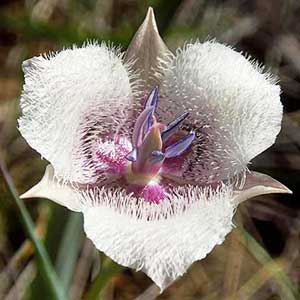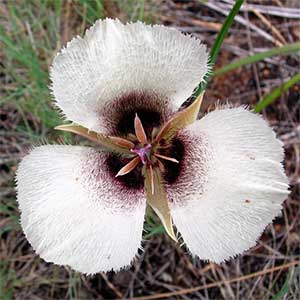|
hairy star tulip, pussy ears, Tolmie star-tulip, Tolmie's cat's ear, Tolmie's mariposa-lily
|
Umpqua mariposa-lily
|
± slender, usually branching, 1–4 dm. |
not branching, straight, often scapelike, 2–3 dm, glabrous or glaucous. |
basal persistent, 1–4 dm; blade lanceolate, tapering at base, flat; cauline bractlike. |
basal solitary, clasping; blade narrowly lanceolate, hairy, adaxially hispid, abaxially glabrous, sometimes glaucous. Inflorescences 1–several-flowered; bracts 2, suboppo-site, narrowly lanceolate. |
± umbellate, 1–several-flowered. |
|
erect or spreading; perianth open, campanulate; sepals 10–15 mm; petals white to pinkish or purplish, obovate, 12–25 mm, adaxial surface densely hairy, margins ciliate; glands bordered proximally by ciliate membrane, distally by short hairs; anthers lanceolate, apex acute to apiculate. |
erect; perianth open, campanulate; sepals lanceolate-acuminate, ca. 2 cm; petals white to cream, with dark purple-black, pentagonal to lunate blotch, broadly oblong to obovate, 3.5 cm, bearded, adaxial surface typically minutely papillose, margins erose; glands transversely oblong-lunate, slightly depressed, with 0.7–1.4 mm-wide band of short dendritic hairs distally, hairs surrounded by lime-green coloration and purple striations; anthers lanceolate, apex acuminate. |
nodding, winged, oblong, 2–3 cm. |
nodding, 3–5.4 cm. |
deep purple, dark brown in age, irregular. |
2.8–3.5 mm, with inflated bulbous crest and hollow lateral ridge. |
= 20. |
= 20. |
|
|
|
|
| Flowering mid spring–mid summer. |
Flowering late spring–mid summer. |
| Open grassy slopes or in woods, often on poor, dry soil |
Grassland-forest ecotones in serpentine-derived soils |
| 0–2000 m (0–6600 ft) |
300–500 m (1000–1600 ft) |
|
CA; OR; WA
|
OR
|
|
Of conservation concern. Calochortus umpquaensis is known only from Watson and Ace Williams mountains on both sides of the Little River, Douglas County. (Discussion copyrighted by Flora of North America; reprinted with permission.) |
| FNA vol. 26, p. 124. |
FNA vol. 26, p. 130. |
| Liliaceae > Calochortus |
Liliaceae > Calochortus |
C. albus, C. amabilis, C. ambiguus, C. amoenus, C. apiculatus, C. argillosus, C. aureus, C. bruneaunis, C. catalinae, C. clavatus, C. coeruleus, C. concolor, C. coxii, C. dunnii, C. elegans, C. eurycarpus, C. excavatus, C. flexuosus, C. greenei, C. gunnisonii, C. howellii, C. indecorus, C. invenustus, C. kennedyi, C. leichtlinii, C. longebarbatus, C. luteus, C. lyallii, C. macrocarpus, C. minimus, C. monanthus, C. monophyllus, C. nitidus, C. nudus, C. nuttallii, C. obispoensis, C. palmeri, C. panamintensis, C. persistens, C. plummerae, C. pulchellus, C. raichei, C. simulans, C. splendens, C. striatus, C. subalpinus, C. superbus, C. tiburonensis, C. umbellatus, C. umpquaensis, C. uniflorus, C. venustus, C. vestae, C. weedii, C. westonii |
C. albus, C. amabilis, C. ambiguus, C. amoenus, C. apiculatus, C. argillosus, C. aureus, C. bruneaunis, C. catalinae, C. clavatus, C. coeruleus, C. concolor, C. coxii, C. dunnii, C. elegans, C. eurycarpus, C. excavatus, C. flexuosus, C. greenei, C. gunnisonii, C. howellii, C. indecorus, C. invenustus, C. kennedyi, C. leichtlinii, C. longebarbatus, C. luteus, C. lyallii, C. macrocarpus, C. minimus, C. monanthus, C. monophyllus, C. nitidus, C. nudus, C. nuttallii, C. obispoensis, C. palmeri, C. panamintensis, C. persistens, C. plummerae, C. pulchellus, C. raichei, C. simulans, C. splendens, C. striatus, C. subalpinus, C. superbus, C. tiburonensis, C. tolmiei, C. umbellatus, C. uniflorus, C. venustus, C. vestae, C. weedii, C. westonii |
| Hooker & Arnott: Bot. Beechey Voy., 398. (1840) |
Fredricks: Syst. Bot. 14: 12, figs. 1, 2, 3f–j, 4, 5. (1989) |
| |

